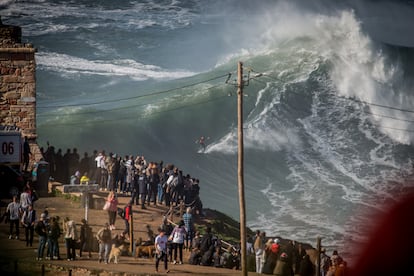The secrets of megatsunamis: Waves over 500 meters high and devastation beyond the ocean
In her latest book, geologist Mercedes Ferrer describes the most significant tsunamis in history, their causes and how to identify them

In Lituya Bay in Alaska, there were only three small boats with six people on board the night of July 10, 1958, when a chaos broke out. The Earth roared and shook as massive waves rose up. An 8.3-magnitude earthquake caused 90 million tons of ice and rocks to fall into the water, creating colossal waves. One of them was 524 meters tall — the largest ever recorded. The walls of water destroyed nearly four square miles of forest, the few surrounding buildings, the bay lighthouse and two of those boats. It is the largest of the 31 megatsunamis recorded in human history.
One of the big differences between megatsunamis and tsunamis is, logically, the height of the waves. A wave taller than 40 meter is considered a megatsunami. Another difference is in what causes them. While earthquakes are the main origin of conventional tsunamis; in the case of megatsunamis, the causes also include large rock falls, land or underwater landslides, volcanic eruptions and the fall of large meteorites in the ocean. All of this is detailed by Mercedes Ferrer, a researcher at the Geological and Mining Institute of Spain, in her book Megatsunamis, which also explains how to identify megatsunamis and describes the most significant ones.
While 58 tsunamis have been recorded in the last 100 years, there is only historical and geological evidence of 31 megatsunamis in human history. In her book, Ferrer explains that they are rare because the phenomena that cause them do not happen very often. The most common cause is large avalanches. These megatsunamis “originate from a large and sudden displacement of material that enters the sea or a lake,” the author explains.
Paradoxically, megatsunamis are not necessarily the most destructive, nor are they always synonymous with devastation. Conventional tsunamis can travel thousands of miles and reach very distant shores. In contrast, landslide-linked megatsunamis are highly concentrated. They can be locally devastating, but they lose energy as they travel further away from the source. “[Megatsunamis] have occurred mainly in isolated areas where there are no human settlements, so in general they have not affected populations or infrastructure,” says Ferrer.
In their wake, these phenomena leave a large amount of material that they drag from the seabed, such as animal remains, mollusks and blocks of sand, which provide evidence that a colossal tsunami occurred there. Thanks to that, there are now records of these exceptional events.
The most devastating recent tsunamis, classified as megatsunamis due to the height of the waves, occurred in Indonesia in 2004 and Japan in 2011. In the first, the waves reached 50 meters, sparked by a magnitude 9.1 underwater earthquake off the coast of Sumatra in the Indian Ocean. That tsunami caused more than 230,000 fatalities, making it the deadliest on record. The tsunami in Japan was caused by another large earthquake of the same magnitude, generating waves of 40 meters, and killing more than 20,000 people.
Reservoirs, lakes and rivers
Five years after the 1958 megatsunami in Alaska, there was another megatsunami, which is the only one attributed to humans. On October 9, 1963, in the Italian Alps, a rock mass of 270 million cubic meters fell from Mount Toc towards the Vaiont reservoir. Although the slope was known to be unstable, no measures had been taken to address the problem. “The sudden landslide expelled about 50 million cubic meters of water and generated a wave measuring more than 260 meters on the opposite slope. The large mass of water flowed into the Piave River valley and destroyed the municipality of Longarone and other towns downstream. More than 2,000 people died, and many others disappeared or were injured as a result of the direct effect of the wave,” says Ferrer.
Megatsunamis do not only occur in the open sea, as they can occur in freshwater bodies of water. In the Grijalva River, located in Chiapas in Mexico, a period of intense rains caused a sudden landslide, with 55 million cubic meters of rocks and earth falling into the right side of the river. This caused a wave more than 50 meters tall that destroyed the population of Juan Grijalva. Although part of the population managed to flee when they heard the roar, more than 30 people lost their lives. “The town literally disappeared under the waves. The river rose more than 30 meters in a few days and more than a million hectares were flooded,” says Ferrer.
The prehistoric megatsunamis of Spain’s Canary Islands have also been closely reviewed by the scientific community. Ferrer studied these events, which occurred in the last hundreds of thousands of years as a result of large landslides in important parts of the islands. Based on the geological remains that have been found, it is estimated that the waves reached heights of 180 and 270 meters in Teno and Isla Baja (Tenerife), respectively, 125 meters in Piedra Alta (Lanzarote) and 290 meters in the Agaete valley (Gran Canaria).
When will the next megatsunami happen?
These phenomena are unpredictable. They can occur at any time or place, so it is not possible to know when the next tsunamis or megatsunamis will occur. However, there are currently effective tools to reduce their effects. Jorge Macías, professor at the University of Malaga in Spain, is a member of the EDANYA research group that works with statistics for the early detection of tsunamis. When an earthquake occurs, specialists perform a real-time simulation to estimate how long it will take for a wave to arrive. They also prepare action maps in case of disaster.
In the case of megatsunamis caused by landslides, “there is not much room for action,” Macías acknowledges. However, in the areas most prone to avalanches, there are mechanisms to detect them. In December 2015, the U.N. General Assembly established November 5 as World Tsunami Awareness Day.
Although there is no scientific evidence to support that climatic conditions influence megatsunamis, it cannot be ruled out. Of the 31 megatsunamis recorded, six have taken place in the last 23 years. Macías warns that giant waves caused by avalanches have been unusually frequent recently. He recognizes that there are now more mechanisms to identify these phenomena in remote areas, but climatic conditions can influence of megatsunamis in areas where ice is melting and causing large rockfalls.
Sign up for our weekly newsletter to get more English-language news coverage from EL PAÍS USA Edition
Tu suscripción se está usando en otro dispositivo
¿Quieres añadir otro usuario a tu suscripción?
Si continúas leyendo en este dispositivo, no se podrá leer en el otro.
FlechaTu suscripción se está usando en otro dispositivo y solo puedes acceder a EL PAÍS desde un dispositivo a la vez.
Si quieres compartir tu cuenta, cambia tu suscripción a la modalidad Premium, así podrás añadir otro usuario. Cada uno accederá con su propia cuenta de email, lo que os permitirá personalizar vuestra experiencia en EL PAÍS.
¿Tienes una suscripción de empresa? Accede aquí para contratar más cuentas.
En el caso de no saber quién está usando tu cuenta, te recomendamos cambiar tu contraseña aquí.
Si decides continuar compartiendo tu cuenta, este mensaje se mostrará en tu dispositivo y en el de la otra persona que está usando tu cuenta de forma indefinida, afectando a tu experiencia de lectura. Puedes consultar aquí los términos y condiciones de la suscripción digital.
More information
Archived In
Últimas noticias
Most viewed
- Reinhard Genzel, Nobel laureate in physics: ‘One-minute videos will never give you the truth’
- Oona Chaplin: ‘I told James Cameron that I was living in a treehouse and starting a permaculture project with a friend’
- Pablo Escobar’s hippos: A serious environmental problem, 40 years on
- Charles Dubouloz, mountaineering star, retires at 36 with a farewell tour inspired by Walter Bonatti
- Why we lost the habit of sleeping in two segments and how that changed our sense of time










































